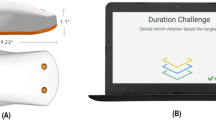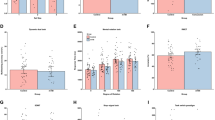Abstract
Effective screening for mild traumatic brain injury (mTBI) is critical to accurate diagnosis, intervention, and improving outcomes. However, detecting mTBI using conventional clinical techniques is difficult, time intensive, and subject to observer bias. We examine the use of a simple visuomotor tracking task as a screening tool for mTBI. Thirty participants, 16 with clinically diagnosed mTBI (mean time since injury: 36.4 ± 20.9 days (95 % confidence interval); median = 20 days) were asked to squeeze a hand dynamometer and vary their grip force to match a visual, variable target force for 3 min. We found that controls outperformed individuals with mTBI; participants with mTBI moved with increased variability, as quantified by the standard deviation of the tracking error. We modeled participants’ feedback response—how participants changed their grip force in response to errors in position and velocity—and used model parameters to classify mTBI with a sensitivity of 87 % and a specificity of 93 %, higher than several standard clinical scales. Our findings suggest that visuomotor tracking could be an effective supplement to conventional assessment tools to screen for mTBI and track mTBI symptoms during recovery.





Similar content being viewed by others
References
Army Individual Test Battery (1944) Manual of directions and scoring. War Department, Adjutant General’s Office, Washington
Brown JA, Dalecki M, Hughes C et al (2015) Cognitive-motor integration deficits in young adult athletes following concussion. BMC Sports Sci Med Rehabil 7:25. doi:10.1186/s13102-015-0019-4
Caeyenberghs K, van Roon D, van Aken K et al (2009) Static and dynamic visuomotor task performance in children with acquired brain injury: predictive control deficits under increased temporal pressure. J Head Trauma Rehabil 24:363–373. doi:10.1097/HTR.0b013e3181af0810
Caeyenberghs K, Leemans A, Geurts M et al (2010) Brain–behavior relationships in young traumatic brain injury patients: fractional anisotropy measures are highly correlated with dynamic visuomotor tracking performance. Neuropsychologia 48:1472–1482. doi:10.1016/j.neuropsychologia.2010.01.017
Ciuffreda KJ, Ludlam DP, Thiagarajan P (2014) Proposed objective visual system biomarkers for mild traumatic brain injury. Mil Med 179:1212–1218. doi:10.7205/MILMED-D-14-00059
Coldren RL, Kelly MP, Parish RV et al (2010) Evaluation of the military acute concussion evaluation for use in combat operations more than 12 hours after injury. Mil Med 175:477–481
Dafotakis M, Sparing R, Eickhoff SB et al (2008) On the role of the ventral premotor cortex and anterior intraparietal area for predictive and reactive scaling of grip force. Brain Res 1228:73–80. doi:10.1016/j.brainres.2008.06.027
Defense Centers of Excellence (2012) Indications and conditions for neuroendocrine dysfunction screening. DCoE Clinical Recommendation, Silver Spring
Dietterich TG (1998) Approximate statistical tests for comparing supervised classification learning algorithms. Neural Comput 10:1895–1923. doi:10.1162/089976698300017197
Eierud C, Craddock RC, Fletcher S et al (2014) Neuroimaging after mild traumatic brain injury: review and meta-analysis. NeuroImage Clin 4:283–294. doi:10.1016/j.nicl.2013.12.009
Faul M, Xu L, Wald M, Coronado V (2010) Traumatic brain injury in the United States: emergency department visits, hospitalizations, and deaths 2002–2006, National Center for Injury Prevention and Control, Atlanta
Fine MS, Thoroughman KA (2007) Trial-by-trial transformation of error into sensorimotor adaptation changes with environmental dynamics. J Neurophysiol 98:1392–1404. doi:10.1152/jn.00196.2007
Fischer TD, Red SD, Chuang AZ et al (2015) Detect of subtle cognitive changes after mTBI using a novel tablet-based task. J Neurotrauma. doi:10.1089/neu.2015.3990
French L, McCrae M, Baggett M (2008) The military acute concussion evaluation (MACE). J Spec Oper Med 8:68–77
Fumeya H, Hideshima H (1994) Cerebellar concussion. Neurol Med Chir 34:612–615
Heitger MH, Anderson TJ, Jones RD et al (2004) Eye movement and visuomotor arm movement deficits following mild closed head injury. Brain 127:575–590. doi:10.1093/brain/awh066
Heitger MH, Jones RD, Dalrymple-Alford JC et al (2006) Motor deficits and recovery during the first year following mild closed head injury. Brain Inj 20:807–824. doi:10.1080/02699050600676354
Heitger MH, Jones RD, Dalrymple-Alford JC et al (2007) Mild head injury—a close relationship between motor function at 1 week post-injury and overall recovery at 3 and 6 months. J Neurol Sci 253:34–47. doi:10.1016/j.jns.2006.11.007
Heitger MH, Jones RD, MacLeod AD et al (2009) Impaired eye movements in post-concussion syndrome indicate suboptimal brain function beyond the influence of depression, malingering or intellectual ability. Brain 132:2850–2870. doi:10.1093/brain/awp181
Hurley RA, Hayman LA, Taber KH (2009) PTSD and combat-related injuries: functional neuroanatomy. J Neuropsychiatry Clin Neurosci 21:1–4
Jordan MI, Wolpert DM (1999) Computational motor control. In: The new cognitive neuroscience, 2nd edn. MIT Press, Cambridge, pp 601–620
Kawato M, Gomi H (1992) A computational model of four regions of the cerebellum based on feedback-error learning. Biol Cybern 68:95–103
Kawato M, Furukawa K, Suzuki R (1987) A hierarchical neural-network model for control and learning of voluntary movement. Biol Cybern 57:169–185. doi:10.1007/BF00364149
Kennedy JE, Jaffee MS, Leskin GA et al (2007) Posttraumatic stress disorder and posttraumatic stress disorder-like symptoms and mild traumatic brain injury. J Rehabil Res Dev 44:895–920. doi:10.1682/JRRD.2006.12.0166
Ketcham CJ, Seidler RD, Van Gemmert AW, Stelmach GE (2002) Age-related kinematic differences as influenced by task difficulty, target size, and movement amplitude. J Gerontol 57:54–64
King NS, Crawford S, Wenden FJ et al (1995) The Rivermead Post Concussion Symptoms Questionnaire: a measure of symptoms commonly experienced after head injury and its reliability. J Neurol 242:587–592
Kroenke K, Spitzer RL, Williams JBW (2001) The PHQ-9: validity of a brief depression severity measure. J Gen Intern Med 16:606–613. doi:10.1046/j.1525-1497.2001.016009606.x
Li KZH, Lindenberger U (2002) Relations between aging sensory/sensorimotor and cognitive functions. Neurosci Biobehav Rev 26:777–783
Marinides Z, Galetta K (2014) Vision testing is additive to the sideline assessment of sports-related concussion. Neurol Clin Pract. doi:10.1212/CPJ.0000000000000060
Maruta J, Lee SW, Jacobs EF, Ghajar J (2010) A unified science of concussion. Ann NY Acad Sci 1208:58–66. doi:10.1111/j.1749-6632.2010.05695.x
Maruta J, Heaton KJ, Kryskow EM et al (2012) Dynamic visuomotor synchronization: quantification of predictive timing. Behav Res Methods 45:289–300. doi:10.3758/s13428-012-0248-3
Mathiowetz V, Kashman N, Volland G et al (1985) Grip and pinch strength: normative data for adults. Arch Phys Med Rehabil 66:69–74. doi:10.1177/1758998313479874
McCrea M (2001) Standardized mental status testing on the sideline after sport-related concussion. J Athl Train 36:274–279
McFarlane AC (2010) The long-term costs of traumatic stress: intertwined physical and psychological consequences. World Psychiatry 9:3–10. doi:10.1002/j.2051-5545.2010.tb00254.x
Michael DB, Byers DM, Irwin LN (2005) Gene expression following traumatic brain injury in humans: analysis by microarray. J Clin Neurosci 12:284–290. doi:10.1016/j.jocn.2004.11.003
Oldfield RC (1971) The assessment and analysis of handedness: the Edinburgh inventory. Neuropsychologia 9:97–113
Potts MB, Adwanikar H, Noble-Haeusslein LJ (2009) Models of traumatic cerebellar injury. Cerebellum 8:211–221. doi:10.1007/s12311-009-0114-8
Prodoehl J, Corcos DM, Vaillancourt DE (2009) Basal ganglia mechanisms underlying precision grip force control. Neurosci Biobehav Rev 33:900–908. doi:10.1016/j.neubiorev.2009.03.004.Basal
Rasmussen CE, Williams CKI (2006) Gaussian processes for machine learning, chap 2. MIT Press, Cambridge. doi:10.1093/bioinformatics/btq657
Shenton ME, Hamoda HM, Schneiderman JS et al (2012) A review of magnetic resonance imaging and diffusion tensor imaging findings in mild traumatic brain injury. Brain Imaging Behav 6:137–192. doi:10.1007/s11682-012-9156-5.A
Stroop J (1935) Studies of interference in serial verbal reactions. J Exp Psychol 18:643–662
Suh M, Kolster R, Sarkar R et al (2006) Deficits in predictive smooth pursuit after mild traumatic brain injury. Neurosci Lett 401:108–113. doi:10.1016/j.neulet.2006.02.074
Tombaugh TN (2004) Trail Making Test A and B: normative data stratified by age and education. Arch Clin Neuropsychol 19:203–214. doi:10.1016/S0887-6177(03)00039-8
US Department of Veterans Affairs National Center for PTSD (2014) Using the PTSD Checklist for DSM-IV (PCL) Handbook, US Department of Veterans Affairs, Washington
Weathers F, Litz B, Herman D et al (1994) The PTSD checklist (PCL): reliability, validity, and diagnostic utility. In: Proceedings of the annual convention of the International Society for Traumatic Stress Studies, San Antonio, TX, USA, pp 24–27
Acknowledgments
Funding was provided by Navy Contract Number QW911QY-09-0041-004, USAMRMC W81XWH-11-1-0632, and internal funding from the MITRE Corporation. The study protocol was approved by the MedStar Health Research Institutional Review Board in compliance with all applicable Federal regulations governing the protection of human subjects. Dr. Norris, Dr. Williams, and Dr. Tsao are employees of the US Government. This work was prepared as part of their official duties. Title 17 U.S.C. §105 provides that ‘Copyright protection under this title is not available for any work of the United States Government.’ Title 17 U.S.C. §101 defines a US Government work as a work prepared by a military service member or employee of the US Government as part of that person’s official duties. The views expressed here are those of the author(s) and should not be construed as the official policy or position of the Department of the Navy, Department of Defense, nor the US Government.
Author information
Authors and Affiliations
Corresponding author
Ethics declarations
Conflict of interest
The authors declare no competing financial interests. The following research is patented under PCT/US2013/058567 and US Patent Application 14/483,741.
Rights and permissions
About this article
Cite this article
Fine, M.S., Lum, P.S., Brokaw, E.B. et al. Dynamic motor tracking is sensitive to subacute mTBI. Exp Brain Res 234, 3173–3184 (2016). https://doi.org/10.1007/s00221-016-4714-5
Received:
Accepted:
Published:
Issue Date:
DOI: https://doi.org/10.1007/s00221-016-4714-5




